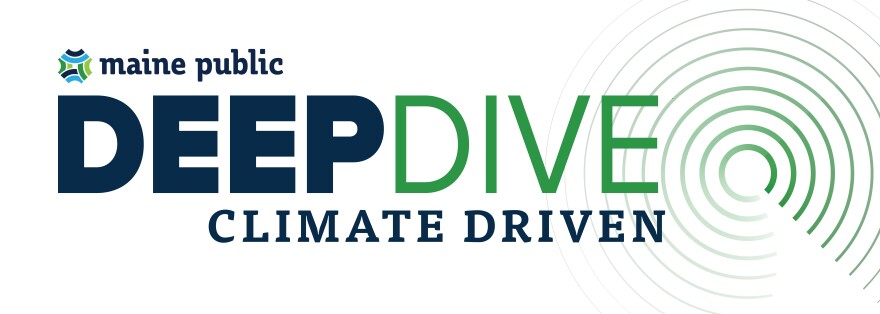At the Bigelow Laboratory for Ocean Sciences, researchers Barney Balch and Catherine Mitchell are looking at a map affixed to a large table.
“We’re looking at a chart of the Gulf of Maine, and right across the middle there’s a line that’s drawn from Portland, in Maine, to Yarmouth, in Nova Scotia," Mitchell says.

This story is part of our series "Climate Driven: A deep dive into Maine's response, one county at a time."
That line is the route along which Bigelow researchers have been taking regular measurements for the last 25 years. They've analyzed chemical and temperature data that help describe how the waters of the gulf are changing. One tool they use is a six-foot long cylinder with wings.
“This is an autonomous underwater vehicle, or a glider," Mitchell says. "So it’s a big robot that moves up and down in a yoyo-like pattern, from the top of the ocean to the bottom of the ocean right across the middle of the Gulf of Maine. So it's measuring a bunch of science things as it goes. It looks a bit like a big yellow torpedo. It's got some wings on it."
A century ago, the oceanographer Henry Bigelow described the blooms of phytoplankton in the Gulf of Maine. Now, research from the East Boothbay lab that bears his name finds that phytoplankton in dramatic decline, and that could have a significant impact on the entire food web of the gulf.
Balch says the research involves NASA satellites first launched in the late 1970s that work in tandem with scientists gathering data out on the water. Balch's colleagues had begun taking samples from a commercial ferry that operated along the same stretch. But then he had a bigger idea.

“It would be wonderful to actually put a full bona fide laboratory on the back of a flatbed truck that we could drive onto the ferry and take measurements from that," he says.
NASA funded the lab on a truck, which took its first ferry ride in 1998. Since then, the lab has taken measurements on more than 200 trips across the gulf, all in sync with the NASA satellites. Using data collected by the satellites, the ferry, research vessels and the glider, Balch says the Bigelow time-series has demonstrated that phytoplankton productivity declined about 65% between 2001 and 2018.
"The part that is the most disconcerting is these are the microscopic plants that you can't see with the naked eye," he says, "yet they are at the bottom of the marine food web on which all life in the sea depends."
Balch says there are many factors at work that may affect phytoplankton in the Gulf of Maine. For starters, air and water temperatures are warming. And there’s more intense rainfall, which can wash tea-colored water into the gulf, blocking sunlight, and also stratifying the water like unmixed salad dressing. That prevents nutrients from welling up to the surface, where they can fertilize the phytoplankton.

“These plants are no different than any other plants, they need two things, they need light, and nutrients to flourish," Balch says. "And if you stratify that ocean, if you cap it off with this low-density water, it makes it harder for them to get the nutrients they need.”
On top of all this, Balch says, the Labrador Current, which used to bring cold water south to the Gulf of Maine is now changing direction and moving more to the east.
To get a closer look at what’s at stake, we walk down to the dock, where a loon is quietly fishing, and the water is deep enough that Henry Bigelow could have pulled his research schooner alongside.
Even on a gray winter day, the water has a deep, rich, blue-green hue. And Mitchell and Balch say there’s a lot going on under there.
“It’s a mix of all these different things," Mitchell says. "There’s the phytoplankton in there, there's sediments in there, there's the dissolved humic tea-like material from the land, the forests and the trees and the grass are in there, and they’re all mixed in together to give that overall color that we’re seeing.”
“There’s information in that color about what different types of plants are there," Balch says, "and that’s our job is to try to decipher that.”
Balch says the combination of warming temperatures and declining phytoplankton suggest that the gulf's productivity won't rebound in the immediate future. But he hopes he's wrong about that.




